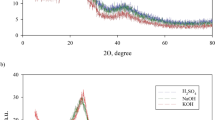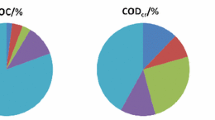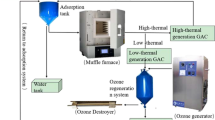Abstract
In this study, regeneration of spent granular activated carbon (GAC) with reactive dye by hydroxyl and sulfate radical-based advanced oxidation processes (microwave (MW) +persulfate (PS)), (Fe(II)+ PS), and (O3 + H2O2) were evaluated. The adsorption of the dye to the GAC surface was characterized by chemisorption and Langmuir isotherm. Regeneration processes have been optimized by the response surface methodology to determine the operating conditions that will provide the highest adsorptive capacity. The optimum conditions of (MW + PS), (Fe (II) + PS), and (O3 + H2O2) processes were process PS anion of 45.52 g/L, pH of 11.4, MW power of 126 W, and duration of 14.56 min; Fe (II) of 3.58 g/L, PS anion of 73.5 g/L, duration of 59.8 min, and pH of 10.9; and H2O2 of 2.8 mole/L, flow rate of 8.14 mg ozone/L, duration of 32.8 min, and pH of 5.3, respectively. For (MW + PS), (Fe (II) + PS), and (O3 + H2O2) processes, the adsorptive capacity under optimum conditions was found as 4.36, 8.89, and 8.12 mg dye/g GAC, respectively. For (Fe (II) + PS) and (O3 + H2O2) processes, these values are approximately equal to the adsorptive capacity of raw GAC (8.01 mg dye/g GAC). The predicted values of the adsorption capacities by the obtained models were in good agreement with the actual experimental results. Preference Ranking Organization Method for Enrichment Evaluation approach was used in the preference of the appropriate regeneration process. The adsorptive capacity of regenerated GAC, operating cost of the regeneration process, change in the adsorptive capacity during the regeneration cycle, and carbon mass loss criteria were taken into account. The order of preference of regeneration processes was determined as (Fe (II) + PS)> (MW + PS)> (O3 + H2O2) considering all criteria.
Graphical abstract







Similar content being viewed by others
Data availability
Not applicable
References
Adewuyi YG, Khan MA (2020) Simultaneous NO and SO2 removal by aqueous persulfate activated by combined heat and Fe2+: experimental and kinetic mass transfer model studies. Environ Sci Pollut Res 27(2):1186–1201. https://doi.org/10.1007/s11356-018-2453-9
Adewuyi YG, Khan MA, Sakyi NY (2014) Kinetics and modeling of the removal of nitric oxide by aqueous sodium persulfate simultaneously activated by temperature and Fe2+. Ind Eng Chem Fundam 53(2):828–839. https://doi.org/10.1021/ie402801b
Ali Y, Pervez H, Khan J (2020) Selection of the most feasible wastewater treatment technology in Pakistan using multi-criteria decision-making (MCDM). Water Conserv Sci Eng 5(3):199–213. https://doi.org/10.1007/s41101-020-00094-6
Alvárez PM, Beltrán FJ, Masa FJ, Pocostales JP (2009) A comparison between catalytic ozonation and activated carbon adsorption/ozone-regeneration processes for wastewater treatment. Appl Catal B 92(3–4):393–400. https://doi.org/10.1016/j.apcatb.2009.08.019
Alvárez PM, Beltrán FJ, Gómez-Serrano V, Jaramillo J, Rodríguez EM (2004) Comparison between thermal and ozone regenerations of spent activated carbon exhausted with phenol. Water Res 38(8):2155–2165. https://doi.org/10.1016/j.watres.2004.01.030
An D, Westerhoff P, Zheng M, Wu M, Yang Y, Chiu CA (2015) UV-activated persulfate oxidation and regeneration of NOM-saturated granular activated carbon. Water Res 73:304–310. https://doi.org/10.1016/j.watres.2015.01.040
Ania CO, Parra JB, Menéndez JA, Pis JJ (2005) Effect of microwave and conventional regeneration on the microporous and mesoporous network and on the adsorptive capacity of activated carbons. Microporous Mesoporous Mater 85(1–2):7–15. https://doi.org/10.1016/j.micromeso.2005.06.013
Bakht Shokouhi S, Dehghanzadeh R, Aslani H, Shahmahdi N (2020) Activated carbon catalyzed ozonation (ACCO) of Reactive Blue 194 azo dye in aqueous saline solution: experimental parameters, kinetic and analysis of activated carbon properties. J Water Process Eng 35:101188. https://doi.org/10.1016/j.jwpe.2020.101188
Balali V, Zahraie B, Roozbahani A (2014) A comparison of AHP and PROMETHEE family decision making methods for selection of building structural system. Am J Civ Eng Archit 2(5):149–159. https://doi.org/10.12691/ajcea-2-5-1
Banar M, Özkan A, Kulaç A (2011) Choosing a recycling system using ANP and ELECTRE III techniques. Turk J Eng Environ Sci 34(3):145–154. https://doi.org/10.3906/muh-0906-47
Bapat S, Jaspal D, Malviya A (2021) Efficacy of parthenium hysterophorus waste biomass compared with activated charcoal for the removal of CI Reactive Red 239 textile dye from wastewater. Color Technol. cote.12526. https://doi.org/10.1111/cote.12526
Barabadi H, Honary S, Ebrahimi P, Alizadeh A, Naghibi F, Saravanan M (2019) Optimization of myco-synthesized silver nanoparticles by response surface methodology employing Box-Behnken design. Inorg Nano-Metal Chem 49(2):33–43. https://doi.org/10.1080/24701556.2019.1583251
Beulah SS, Muthukumaran K (2020) Methodologies of removal of dyes from wastewater: a review. Int Res J Pure Appl Chem IRJPAC(11):68–78. https://doi.org/10.9734/irjpac/2020/v21i1130225
Brans JP, Vincke P, Mareschal B (1986) How to select and how to rank projects: the PROMETHEE method. Eur J Oper Res 24(2):228–238. https://doi.org/10.1016/0377-2217(86)90044-5
Cabrera-Codony A, Gonzalez-Olmos R, Martín MJ (2015) Regeneration of siloxane-exhausted activated carbon by advanced oxidation processes. J Hazard Mater 285:501–508. https://doi.org/10.1016/j.jhazmat.2014.11.053
Charnkeitkong P, Phoophuangpairoj R (2020) Modification of Manila grass activated carbon for reactive dye adsorption from textile printing wastewater. IOP Conf Ser Mater Sci Eng 733(1):012043. https://doi.org/10.1088/1757-899X/733/1/012043
Durán-Jiménez G, Stevens LA, Hodgins GR, Uguna J, Ryan J, Binner ER, Robinson JP (2019) Fast regeneration of activated carbons saturated with textile dyes: textural, thermal and dielectric characterization. Chem Eng J 378:121774. https://doi.org/10.1016/j.cej.2019.05.135
Durna E, Erkişi E, Genç N (2020a) Regeneration of diclofenac-spent granular activated carbon by sulphate radical based methods: multi-response optimisation of adsorptive capacity and operating cost. Int J Environ Anal Chem 1–15. https://doi.org/10.1080/03067319.2020.1787399
Durna E, Koz G, Genç N (2020b) Determination of the most suitable disposal option in the management of end of life tires in Turkey by PROMETHEE and fuzzy PROMETHEE method. J Polytech 23:915–927. https://doi.org/10.2339/politeknik.591100
Ge X, Ma X, Wu Z, Xiao X, Yan Y (2015) Modification of coal-based activated carbon with nitric acid using microwave radiation for adsorption of phenanthrene and naphthalene. Res Chem Intermed 41(10):7327–7347. https://doi.org/10.1007/s11164-014-1815-2
Ge X, Wu Z, Wu Z, Yan Y, Cravotto G, Ye BC (2016) Microwave-assisted modification of activated carbon with ammonia for efficient pyrene adsorption. J Ind Eng Chem 39:27–36. https://doi.org/10.1016/j.jiec.2016.05.003
Genç N, Durna E, Erkişi E (2021) Optimization of the adsorption of diclofenac by activated carbon and the acidic regeneration of spent activated carbon. Water Sci Technol 83(2):396–408. https://doi.org/10.2166/wst.2020.577
He X, Elkouz M, Inyang M, Dickenson E, Wert EC (2017) Ozone regeneration of granular activated carbon for trihalomethane control. J Hazard Mater 326:101–109. https://doi.org/10.1016/j.jhazmat.2016.12.016
Huling SG, Ko S, Park S, Kan E (2011) Persulfate oxidation of MTBE- and chloroform-spent granular activated carbon. J Hazard Mater 192(3):1484–1490. https://doi.org/10.1016/j.jhazmat.2011.06.070
Hutson A, Ko S, Huling SG (2012) Persulfate oxidation regeneration of granular activated carbon: reversible impacts on sorption behavior. Chemosphere 89(10):1218–1223. https://doi.org/10.1016/j.chemosphere.2012.07.040
Jatta S, Huang S, Liang C (2019) A column study of persulfate chemical oxidative regeneration of toluene gas saturated activated carbon. Chem Eng J 375:122034. https://doi.org/10.1016/j.cej.2019.122034
Larasati A, Fowler GD, Graham NJD (2020) Chemical regeneration of granular activated carbon: preliminary evaluation of alternative regenerant solutions. Environ Sci Water Res Technol 6(8):2043–2056. https://doi.org/10.1039/d0ew00328j
Lee S, Vaccari M, Tudor T (2016) Considerations for choosing appropriate healthcare waste management treatment technologies: a case study from an East Midlands NHS Trust, in England. J Clean Prod 135:139–147
Leng CC, Pinto NG (1996) An investigation of the mechanisms of chemical regeneration of activated carbon. Ind Eng Chem Res 35(6):2024–2031. https://doi.org/10.1021/ie950576a
Liang C, Lin YT, Shin WH (2009) Persulfate regeneration of trichloroethylene spent activated carbon. J Hazard Mater 168(1):187–192. https://doi.org/10.1016/j.jhazmat.2009.02.006
Liu Z, Ren B, Ding H, He H, Deng H, Zhao C, Wang P, Dionysiou DD (2020) Simultaneous regeneration of cathodic activated carbon fiber and mineralization of desorbed contaminations by electro-peroxydisulfate process: advantages and limitations. Water Res 171:115456. https://doi.org/10.1016/j.watres.2019.115456
Lu PJ, Lin HC, Yu WT, Chern JM (2011) Chemical regeneration of activated carbon used for dye adsorption. J Taiwan Inst Chem Eng 42(2):305–311. https://doi.org/10.1016/j.jtice.2010.06.001
McQuillan RV, Stevens GW, Mumford KA (2018) The electrochemical regeneration of granular activated carbons: a review. J Hazard Mater 55:34–49. https://doi.org/10.1016/j.jhazmat.2018.04.079
Moradi O, Fakhri A, Adami S, Adami S (2013) Isotherm, thermodynamic, kinetics, and adsorption mechanism studies of ethidium bromide by single-walled carbon nanotube and carboxylate group functionalized single-walled carbon nanotube. J Colloid Interface Sci 395(1):224–229. https://doi.org/10.1016/j.jcis.2012.11.013
Moyo LB, Iyuke SE, Muvhiiwa RF, Simate GS, Hlabangana N (2021) Application of response surface methodology for optimization of biodiesel production parameters from waste cooking oil using a membrane reactor. South African J Chem Eng 35:1–7. https://doi.org/10.1016/j.sajce.2020.10.002
Oladejo J, Shi K, Chen Y, Luo X, Gang Y, Wu T (2020) Closing the active carbon cycle: regeneration of spent activated carbon from a wastewater treatment facility for resource optimization. Chem Eng Process Process Intensif 150:107878. https://doi.org/10.1016/j.cep.2020.107878
Osmanbaşoğlu M, Ozkan A, Günkaya Z, Banar M (2019) Application of analytic network process (ANP) and PROMETHEE for different treatment/disposal technologies of persistent organic pollutants (POPs). Environ Res Technol 2(1):19–25
Patel S, Majumder SK, Das P, Ghosh P (2019) Ozone microbubble-aided intensification of degradation of naproxen in a plant prototype. J Environ Chem Eng 7(3):103102. https://doi.org/10.1016/j.jece.2019.103102
Rais S, Islam A, Ahmad I, Kumar S, Chauhan A, Javed H (2021) Preparation of a new magnetic ion-imprinted polymer and optimization using Box-Behnken design for selective removal and determination of Cu(II) in food and wastewater samples. Food Chem 334:127563. https://doi.org/10.1016/j.foodchem.2020.127563
Sahu UK, Mahapatra SS, Patel RK (2018) Application of Box–Behnken Design in response surface methodology for adsorptive removal of arsenic from aqueous solution using CeO2/Fe2O3/graphene nanocomposite. Mater Chem Phys 207:233–242. https://doi.org/10.1016/j.matchemphys.2017.11.042
Salvador F, Martin-Sanchez N, Sanchez-Hernandez R, Sanchez-Montero MJ, Izquierdo C (2015a) Regeneration of carbonaceous adsorbents. Part I: Thermal Regeneration. Microporous Mesoporous Mater 202:259–276. https://doi.org/10.1016/j.micromeso.2014.02.045
Salvador F, Martin-Sanchez N, Sanchez-Hernandez R, Sanchez-Montero MJ, Izquierdo C (2015b) Regeneration of carbonaceous adsorbents. Part II: Chemical, Microbiological and Vacuum Regeneration. Microporous Mesoporous Mater 202:277–296. https://doi.org/10.1016/j.micromeso.2014.08.019
San Cristobal JR (2013) Critical path definition using multicriteria decision making: PROMETHEE method. J Manag Eng 29(2):158–163. https://doi.org/10.1061/(ASCE)ME.1943-5479.0000135
Santos DHS, Duarte JLS, Tonholo J, Meili L, Zanta CLPS (2020) Saturated activated carbon regeneration by UV-light, H2O2 and Fenton reaction. Sep Purif Technol 250:117112. https://doi.org/10.1016/j.seppur.2020.117112
Senthil Kumar P (2014) Adsorption of lead(II) ions from simulated wastewater using natural waste: a kinetic, thermodynamic and equilibrium study. Environ Prog Sustain Energy 33(1):55–64. https://doi.org/10.1002/ep.11750
Singh R, Bhunia P, Dash RR (2019) Optimization of organics removal and understanding the impact of HRT on vermifiltration of brewery wastewater. Sci Total Environ 651:1283–1293. https://doi.org/10.1016/j.scitotenv.2018.09.307
Srikanth HV, Venkatesh J, Godiganur S (2021) Box-Behnken response surface methodology for optimization of process parameters for dairy washed milk scum biodiesel production. Biofuels 12(1):113–123. https://doi.org/10.1080/17597269.2018.1461511
Vakili M, Zwain HM, Mojiri A, Wang W, Gholami F, Gholami Z, Giwa AS, Wang B, Cagnetta G, Salamatinia B (2020) Effective adsorption of reactive black 5 onto hybrid hexadecylamine impregnated chitosan-powdered activated carbon beads. Water 12(8):2242. https://doi.org/10.3390/w12082242
Xiao X, Tian F, Yan Y, Wu Z, Wu Z, Cravotto G (2015) Adsorption behavior of phenanthrene onto coal-based activated carbon prepared by microwave activation. Korean J Chem Eng 32(6):1129–1136. https://doi.org/10.1007/s11814-014-0317-7
Zanella O, Tessaro IC, Féris LA (2014) Desorption- and decomposition-based techniques for the regeneration of activated carbon. Chem Eng Technol 37(9):1447–1459. https://doi.org/10.1002/ceat.201300808
Zhang CL, Qiao GL, Zhao F, Wang Y (2011) Thermodynamic and kinetic parameters of ciprofloxacin adsorption onto modified coal fly ash from aqueous solution. J Mol Liq 163(1):53–56. https://doi.org/10.1016/j.molliq.2011.07.005
Zhi Y, Liu J (2016) Surface modification of activated carbon for enhanced adsorption of perfluoroalkyl acids from aqueous solutions. Chemosphere 144:1224–1232. https://doi.org/10.1016/j.chemosphere.2015.09.097
Author information
Authors and Affiliations
Contributions
Study conceptualization, investigation, manuscript reviewing, and editing were performed by Nevim GENÇ and Elif DURNA, and experimental analysis was performed by Esin KACIRA.
Corresponding author
Ethics declarations
Ethics approval
Not applicable.
Consent to participate
Not applicable.
Consent for publication
Not applicable.
Competing interests
The authors declare no competing interests.
Additional information
Responsible Editor: Ricardo A. Torres-Palma
Publisher’s note
Springer Nature remains neutral with regard to jurisdictional claims in published maps and institutional affiliations.
Supplementary information
ESM 1
(DOCX 6.45 mb)
Rights and permissions
About this article
Cite this article
Genç, ., Durna, E. & Kacıra, E. The preference of the most appropriate radical-based regeneration process for spent activated carbon by the PROMETHEE approach. Environ Sci Pollut Res 29, 5240–5255 (2022). https://doi.org/10.1007/s11356-021-15833-y
Received:
Accepted:
Published:
Issue Date:
DOI: https://doi.org/10.1007/s11356-021-15833-y




